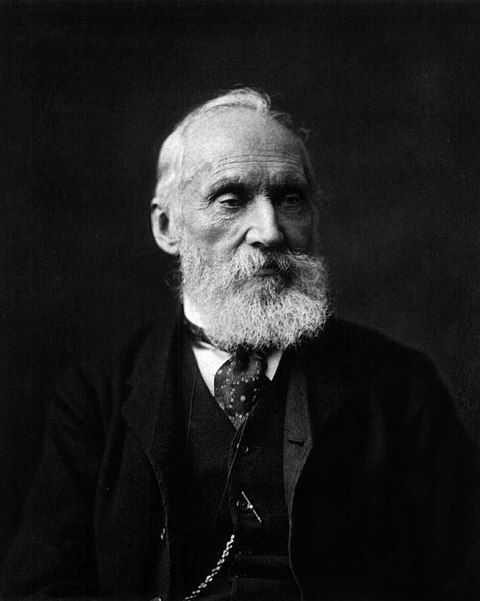 Lord Kelvin: still natural philosophical after all these years
Lord Kelvin: still natural philosophical after all these years
If we accept the working idea that 18th-century natural philosophy could be characterized by philosophers’ willingness to incorporate ideas about the physical nature of the world into a general scheme accounting for various natural “economies” or “cosmologies” that flowed into questions encompassing the characteristics of life, body, mind, epistemology, ethics, society, theology, and politics; then we need to define how far this universalizing philosophical practice extended, both temporally and within particular cultures, and what sorts of things have happened at the boundaries.
This was an active question through the 1980s. One common answer was professionalization and specialization (not to be conflated!—notably see Paul Lucier’s “The Professional and the Scientist in Nineteenth-Century America” in the latest Isis; the piece opens with an unusually lively historiographical discussion). In 1983, Simon Schaffer saw boundary creation as a consequence of the political dangers attributable to public natural philosophical demonstrations. Jack Morrell and Arnold Thackray were also very clear on this point in Gentlemen of Science: Early Years of the British Association for the Advancement of Science (1981), discussing how the BA was established in the 1830s, both to promote scientific work, and to constrain the bounds of (and thus objections to) scientific investigation and thought.
It was likewise in this same early-to-mid 19th-century British context that William Whewell (1794-1866) coined the term “scientist” in response to an injunction by Samuel Coleridge (1772-1834) that men of science should not pretend to the more general and eminent title of philosopher. (See also Schaffer (1991) on Whewell as a critic of knowledge claims.) In 1986, Schaffer had been very explicit in denoting the establishment of new philosophies and institutions of science as signaling the “end of natural philosophy”, which also entailed the rewriting of histories of older discoveries to accommodate the new understanding of “science”, singular.
Of course, natural philosophy did not “end”. To begin with, “scientists” were by no means prevented from discussing issues outside of their defined jurisdictions, nor, conversely, was delimited expertise devoid of broader implications. In fact, the term “scientist” did not even catch on until much later. However, it is clear that the situation did change, and some effort was put into figuring out how the intellectual and moral terrain of science was reconfigured.
Crosbie Smith and Norton Wise discussed the “changing tradition of natural philosophy” in chapter four of their Energy and Empire (1989), which revolved around the 1840s efforts of James Thomson to secure the Glasgow chair in natural philosophy for his son William Thomson (later Lord Kelvin, 1824-1907), which William would hold until his death. But the chapter also discussed thinking about the Scottish tradition in natural philosophy, and how its experimental and theoretical concerns conflicted with but also—thanks in large part to Thomson—began to draw upon the mathematical liberal pedagogy of the Cambridge tripos (which, by the way, Andy Warwick started researching in 1980s Cambridge HPS).
Importantly, the Scottish tradition also had a strong commitment to moral philosophy and religion—particularly in the general notion of a divinely ordered universe—which was certainly manifest in Thomson’s thought, publications, and public rhetoric. These broader aspects of Scottish scientific thought certainly shared much with Whewell’s wide-ranging conservative Anglican philosophy, with, of course, important particular political and religious differences.
Here was a great opportunity to parse some issues about where “scientific” work ended and other forms of discourse began in that 19th-century context (please excuse the demarcationist terminology; the term was of course hotly contested). One clearly emergent phenomenon was the newly intensified role of precise measurement in 19th-century physical sciences. Jed Buchwald’s 1989 account of Fresnel’s mainly-1820s mathematical treatment of polarization measurements leading to the acceptance of the wave theory of light, as championed by Cambridge mixed mathematicians and BA members, demonstrated the importance of the development in allowing science to claim certainty on certain tightly constrained questions. Thomson’s own work on metrology and his mathematical account of thermodynamics and electromagnetism (extended and amended by Maxwell) clearly built on and extended the gains forged by people like Fresnel.
However, Thomson also ventured well beyond the precisely measurable into questions such as thermodynamics’ implications for defining a possible age of the sun and earth, with attendant conflicts with the sciences of geology and natural history, including the surging ideological rhetoric of science surrounding Darwinism. (See also a recent post on late-19th-century spiritualism, with discussion of scientists’ involvement, at the fine new blog Heterodoxology.) How do these activities square the changing tradition of natural philosophy with the rising tradition of a mathematical, precision-based physics; what were the purported and perceived epistemic statuses of claims such as these? On the other end, how do these activities square with contemporary presentations of scientific work to the public, or high-level scientists’ responsibilities to engage certain publics, speaking as generically intellectual (rather than truth-bearing expert) figures?
My feeling is that relating clearly scientific practices to non-scientific or vaguely related scientific concerns or rhetoric is the point where the historiography became overburdened. As I have noted here, Smith and Wise formulated their reading of Thomson’s work, thought, and advocacy all in terms of underlying commitments to religious and political voluntarism, which Buchwald, expressing reservation, referred to as a “fractal” approach, and which Schaffer (in 1984, discussing the historiography of Joseph Priestley, 1733-1804) derided as “synoptic”.
However, the prospect of resorting to a set of overbearing political-religious influences was still quite acceptable even circa 1990. To describe Thomson’s overarching religious-intellectual commitments, Smith and Wise (to Buchwald’s chagrin) used the term “theology of nature”, which was a device used very explicitly by Geoffrey Cantor to discuss the work of Michael Faraday (1791-1867) in Michael Faraday: Sandemanian and Scientist (1991), chapter seven.
We will return to Cantor, Faraday, the theology of nature, and the bounds of natural philosophy question more generally in Pt. 2.